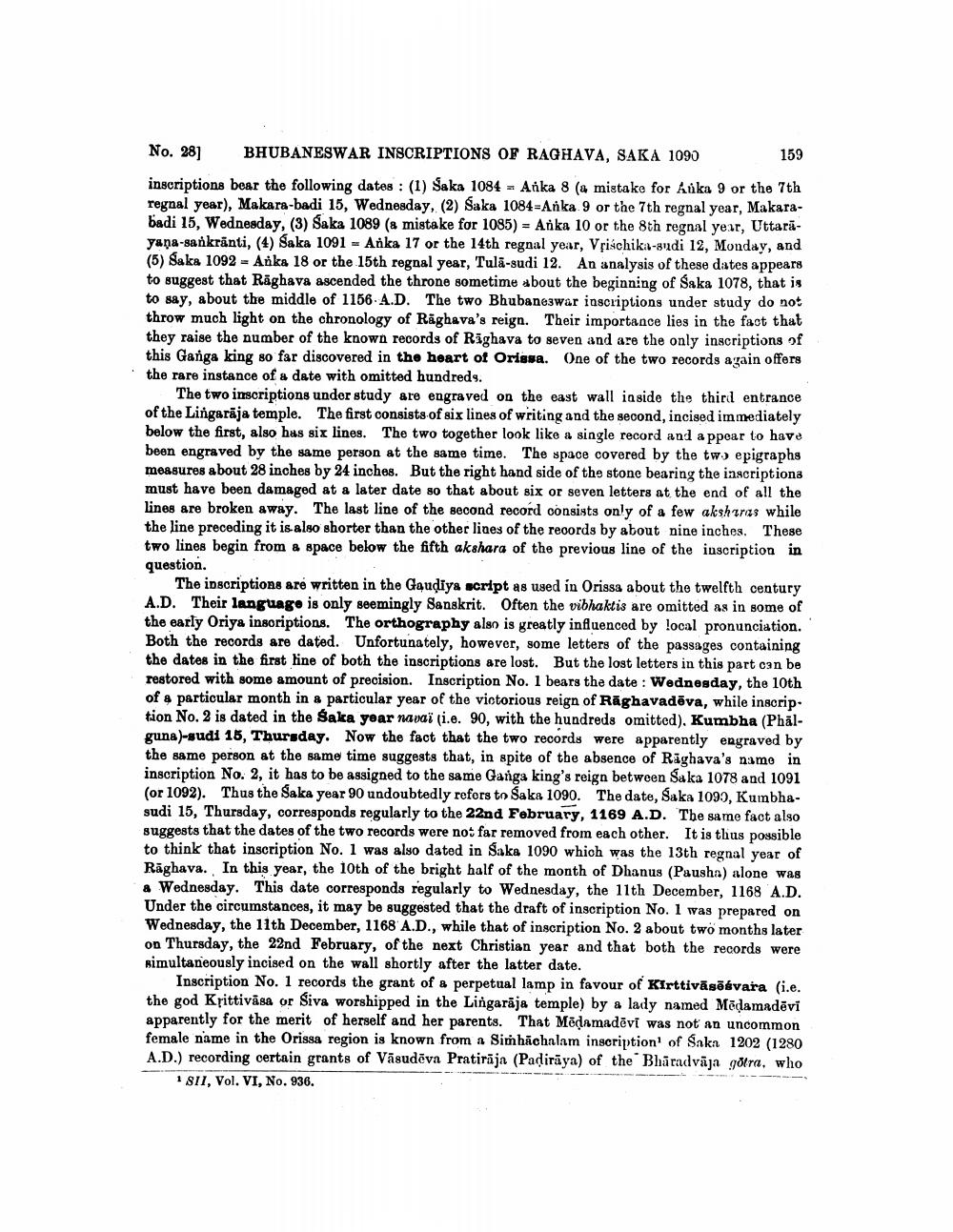________________
No. 28]
BHUBANESWAR INSCRIPTIONS OF RAGHAVA, SAKA 1090
159
inscriptions bear the following dates : (1) Saka 1084 - Anka 8 (« mistake for húka 9 or the 7th regnal year), Makara-badi 15, Wednesday, (2) Saka 1084=Anka 9 or the 7th regnal year, Makarabadi 15, Wednesday, (3) Saka 1089 (& mistake for 1085) = Anka 10 or the 8th regnal year, Uttarayuna-sankranti, (4) Saka 1091 - Anka 17 or the 14th regnal year, Vrischikt-eudi 12, Monday, and (5) Saka 1092 - Anka 18 or the 15th regnal year, Tula-sudi 12. An analysis of these dates appears to suggest that Rāghava ascended the throne sometime about the beginning of Saka 1078, that is to say, about the middle of 1156-A.D. The two Bhubaneswar inscriptions under study do not throw much light on the chronology of Raghava's reign. Their importance lies in the fact that they raise the number of the known records of Righava to seven and are the only inscriptions of this Ganga king so far discovered in the heart of Orissa. One of the two records again offers the rare instance of a date with omitted hundreds.
The two inscriptions under study are engraved on the east wall inside the third entrance of the Lingarāja temple. The first consists of six lines of writing and the second, incised immediately below the first, also has six lines. The two together look like a single record and appear to have been engraved by the same person at the same time. The space covered by the two epigraphs measures about 28 inches by 24 inches. But the right hand side of the stone bearing the inscriptions must have been damaged at a later date so that about six or seven letters at the end of all the lines are broken away. The last line of the second record consists only of a few akshares while the line preceding it is also shorter than the other lines of the records by about nine inches. These two lines begin from & space below the fifth akshara of the previous line of the inscription in question.
The inscriptions are written in the Gaudiya script as used in Orissa about the twelfth century A.D. Their language is only seemingly Sanskrit. Often the vibhaktis are omitted as in some of the early Oriya insoriptions. The orthography also is greatly influenced by local pronunciation. Both the records are dated. Unfortunately, however, some letters of the passages containing the dates in the first line of both the inscriptions are lost. But the lost letters in this part can be restored with some amount of precision. Inscription No. 1 bears the date: Wednesday, the 10th of a particular month in a particular year of the victorious reign of Rāghavadēva, while inscrip tion No. 2 is dated in the Saka year mapai (i.e. 90, with the hundreds omitted), Kumbha (Phalguna)-sudi 15, Thursday. Now the fact that the two records were apparently engraved by the same person at the same time suggests that, in spite of the absence of Raghava's name in inscription No. 2, it has to be assigned to the same Ganga king's reign between Saka 1078 and 1091 (or 1092). Thus the Saka year 90 undoubtedly refers to Saka 1090. The date, Saka 1095, Kumbhasudi 15, Thursday, corresponds regularly to the 22nd February, 1169 A.D. The same fact also suggests that the dates of the two records were not far removed from each other. It is thus possible to think that inscription No. 1 was also dated in Saka 1090 which was the 13th regnal year of Rāghava. In this year, the 10th of the bright half of the month of Dhanus (Pausha) alone was a Wednesday. This date corresponds regularly to Wednesday, the 11th December, 1168 A.D. Under the circumstances, it may be suggested that the draft of inscription No. I was prepared on Wednesday, the 11th December, 1168 A.D., while that of inscription No. 2 about two months later on Thursday, the 22nd February, of the next Christian year and that both the records were simultaneously incised on the wall shortly after the latter date.
Inscription No. 1 records the grant of a perpetual lamp in favour of Kirttivāsāśvara (i.e. the god Krittivāsa or Siva worshipped in the Lingarāja temple) by a lady named Mēdamadēvi apparently for the merit of herself and her parents. That Mēdamadēvi was not an uncommon female name in the Orissa region is known from a Simhachalam inscription of Saka 1202 (1280 A.D.) recording certain grants of Vāsudēva Pratirāja (Padirāya) of the Bharadvāja götra, who
1 SI1, Vol. VI, No. 936.




